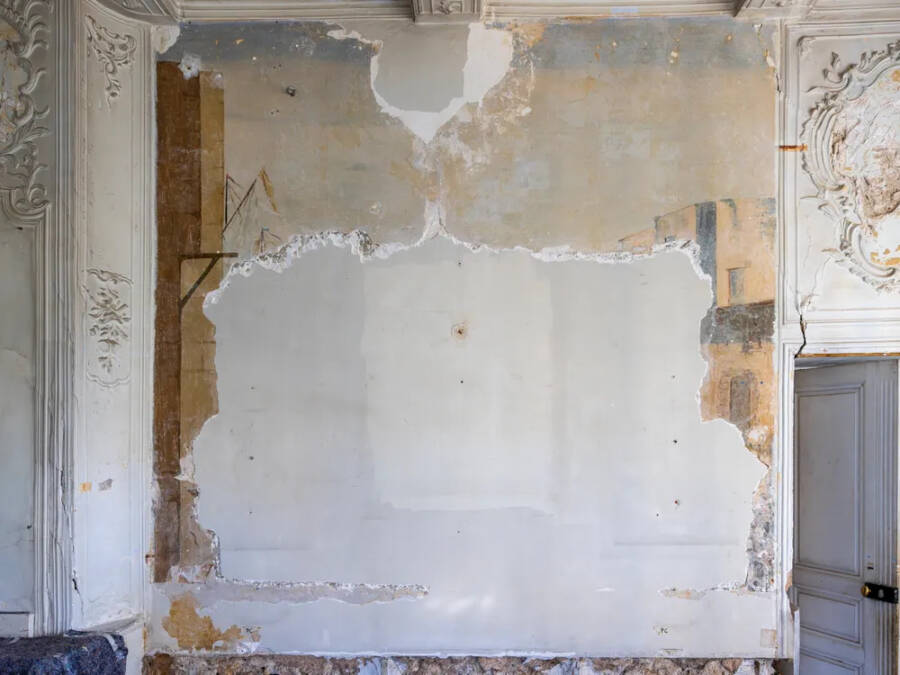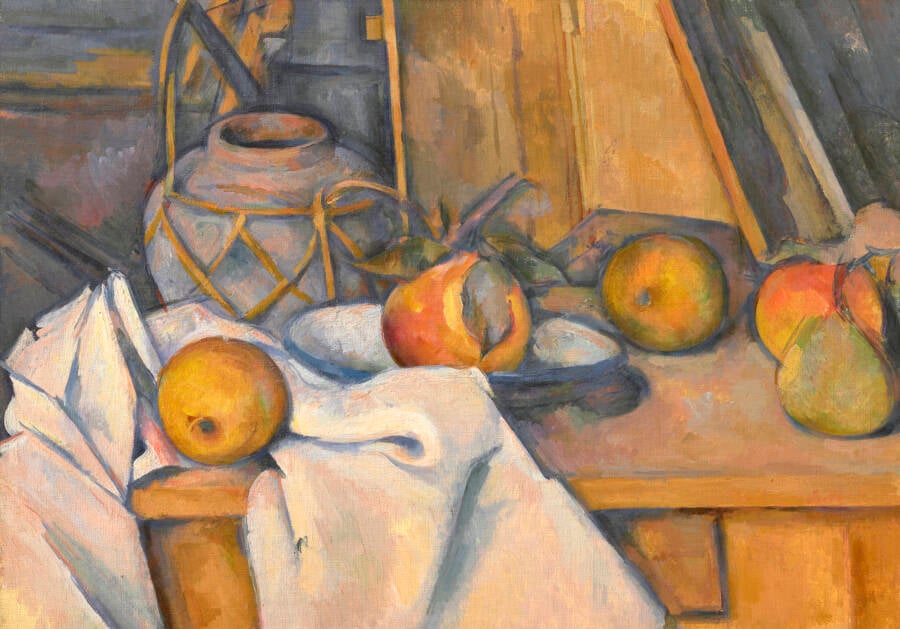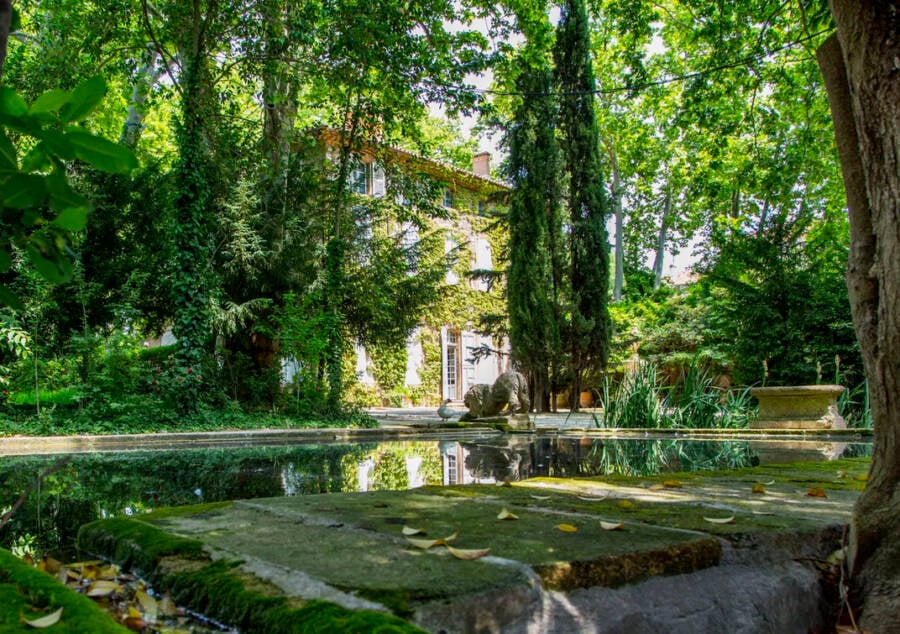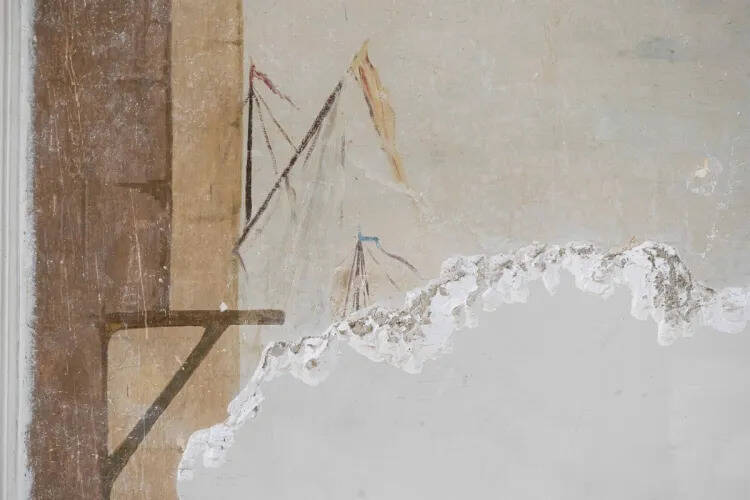Often referred to as the "father of modern art," French painter Paul Cézanne created several murals in his childhood home — and workers renovating the mansion have discovered a new mural no one knew was there.

Ville d’Aix-en-Provence/Philippe BiolattoWorkers at Cézanne’s childhood home discovered this previously unknown mural, now referred to as the Entrée du port.
In August 2023, workers renovating the childhood home of artist Paul Cézanne in France made an astonishing discovery. After removing layers of wallpaper, plaster, and paint from a wall in the mansion’s main living room, they uncovered a previously unknown mural by the “father of modern art.”
Now known as Entrée du port, the 64-square-foot mural showcases a maritime scene, and although a large portion of the mural has been destroyed, experts can still identify “floating pennons [banners], masts, a sky that stretches across the upper part of the wall, and architectural elements running along the sides,” according to Art Newspaper.
The discovery of this piece has opened new doors to understanding the life and work of one of the greatest Post-Impressionists of all time.
The Discovery Of Paul Cézanne’s Hidden Mural

Public DomainPaul Cézanne, Fruits et pot de gingembre, 1890-1893. Oil on canvas.
Born Jan. 19, 1839 in Aix-en-Provence, France, Paul Cézanne is well known for his quaint still lifes and distinct approach to perspective. He is best known for spearheading the Post-Impressionist art movement, a style of art that embraced distorted depictions of light and color.
Cézanne produced dozens of murals and paintings at his childhood home, Bastide du Jas de Bouffan in Aix-en-Provence, France. Experts had long believed Cézanne created only nine works directly on the walls of the mansion’s Grand Salon, but this recent discovery shakes up experts’ preconceived ideas.
“We were just thunderstruck,” Cézanne scholar Mary Tompkins Lewis, one of the experts invited to see the mural last year, told NPR. “It was a very exciting moment.”
Understanding Cézanne’s Evolution Through His Murals

Ville d’Aix-en-ProvenceBastide du Jas de Bouffan, Cézanne’s childhood home in Aix-en-Provence, France.
While Paul Cézanne’s work defined a new era of artistic expression, not everyone in his personal life encouraged him to pursue art. For one, Cézanne’s father desperately tried to persuade his son to practice law and manage the family-owned bank.
Still, Cézanne’s father allowed him to explore his love for art on the walls of their home. It is from these works that experts can now piece together the artist’s artistic evolution.
“The artwork expands our understanding of how the artist developed his style,” Tompkins Lewis told NPR. “We really see him grow up from a provincial painter trying to please his father to this young rebellious artist who would take on the world in Paris.”
Within the Entrée du port, experts can identify the influence other artists had on the young painter. According to Art Newspaper, Claude-Joseph Vernet or Claude Lorrain, two French artists who often painted seaports in their work, may have influenced the subject of the Entrée du port.
Overall, the newly discovered mural provides experts with greater insight into Cézanne and opens up opportunities to redefine his life’s work.
“It is the last in situ testimony of the artist’s work in his bastide,” officials stated, according to the Smithsonian. “It allows us to perceive and understand, from the works of the ‘Grand Salon’… the pictorial revolution that the artist carried out, moving from works considered decorative to works asserting his personality as an artist.”
The Fate Of The Entrée Du Port Mural

Ville d’Aix-en-Provence/Philippe BiolattoA closeup of the Entrée du port.
Over the years, several of Paul Cézanne’s murals have been removed from the home and placed in museums around the world. As for the Entrée du port, experts plan on leaving it in the artist’s childhood home.
“This mural that we discovered, we’re going to leave it; we’re going to keep it there,” Société Paul Cézanne president Denis Coutagne told NPR. “It’s the result of continuous restoration work on the Grand Salon, with a view to its reopening in 2025.”
The city of Aix-en-Provence plans to host a celebration of the artist in 2025, and visitors will hopefully be able to view the restored Bastide du Jas de Bouffan and the Entrée du port.
“The public will then be able to discover this place, enriched by the updating of its first paintings produced from 1859,” Sophie Joissains, mayor of Aix-en-Provence, told Smithsonian, “as well as by the arrival in Aix of the most famous of Cézanne’s paintings, The Card Players.”
After reading about the discovery of Paul Cézanne’s mural, dive into the works of the seven greatest Surrealist artists of all time. Then, read about how the theft of the Mona Lisa made it the masterpiece we know it as today.





